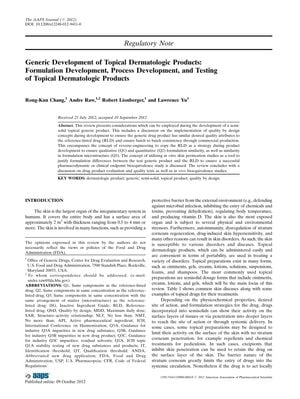Generic Development of Topical Dermatologic Products: Formulation Development, Process Development, and Testing of Topical Dermatologic Products
October 2012
in “The AAPS Journal”

TLDR The document concludes that developing generic topical drugs requires ensuring they match the original in quality, composition, and structure, and often involves complex testing and regulatory steps.
The 2012 document provides comprehensive guidance on the development of generic topical dermatologic products, focusing on the importance of quality by design (QbD) and the need to achieve similar quality attributes to the reference-listed drug (RLD). It emphasizes the necessity of reverse-engineering the RLD to ensure qualitative and quantitative formulation similarity (Q1/Q2), as well as microstructural similarity (Q3). The document highlights the role of in vitro skin permeation studies in justifying formulation differences and supporting bioequivalence studies, and the importance of in vivo bioequivalence studies, including pharmacodynamic tests like the vasoconstrictor activity test for corticosteroids. It also discusses the critical aspects of formulation design, process development, testing, and regulatory requirements, including the avoidance of unwanted ingredient interactions, the selection of solvents, the impact of viscosity, and the use of preservatives and antioxidants. The document underscores the complexity of formulating generic topical products and the importance of maintaining the drug product's physical and chemical properties throughout its shelf-life, characterizing the RLD, and ensuring patient acceptance for commercial success. Stability data is crucial for regulatory filing, and a biowaiver may be granted under certain conditions, although in vivo bioequivalence studies are generally required.
View this study on europepmc.org →